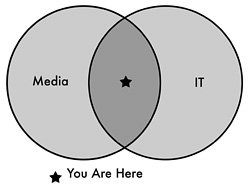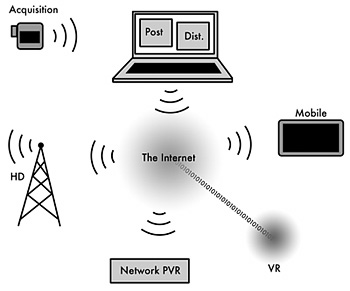IT Just Doesn't Get it!

The engineer Charles Kettering said, "There is a great difference between knowing and understanding: you can know a lot about something and not really understand it." A good example of this is the engineer who knows a lot about IT from experience in general IT and has recently come into media. If you look at Fig. 1, you see what is now entirely obvious. The world of media and the world of IT are converging. If you read this column, you are very likely someone at the intersection of these two disciplines, and probably came from the media world.
One thing you see in this column and elsewhere is the call for those with strong media technology backgrounds to become more familiar with IT. But I am pretty sure you feel occasionally frustrated with the folks who come from a "standard" IT background. It may seem there are some basic things that they just don't get.
Well, this thing we do is not just IT. It is not yet the dream of an IT-centric future as characterized in Fig. 2. There are a number of aspects of the media business and its technologies that differ from general IT. As much as it is important for you to get your head around IT technology and concepts, it is equally important that IT folks learn some of the basic differences so they can be effective as well.
UNIQUE SOLUTIONS

Fig. 1: Media technology and IT technology are converging.
One of the most important differences of the media industry is its unique culture. Media organizations are craft-oriented and heavily collaborative. Any engineer who has had to deal with IT consultants unfamiliar with media is aware of the difficulties that occur when implementing IT solutions while ignoring media culture. Those from other industries have a hard time getting their heads around the concept of "craft," or the fact that a certain amount of creativity needs to go into every asset produced by a media facility. Media production is not entirely an assembly line process. There are certainly large areas of production that can benefit from heavy business process orchestration and formalized rules. But there's also a little bit of reinventing the wheel that must be done every single time, simply because creativity is involved. This means an abundance of purposeful exception cases. No one wants to make the exact same TV show twice.
Another critical difference is the time-based nature of many aspects of media. While the real-time domain of technology has been shrinking with file-based systems, there is still a real-time component. If nothing else, it is because the consumption of the product (content) can only occur in real time. Another way of looking at it is that you simply cannot go off air. While an e-mail can be delayed 5 seconds and it will make little difference, the same is not true for a TV signal loss.
BUILD A SOLID CORE
This requires some differences in the way systems and technology are architected. The reliability requirements are very high. "Five 9s" reliability is not enough. It also makes a difference in how systems are maintained. As performance requirements are very high, it is not acceptable to simply patch an operating system or add a virus scanner. Small changes in the performance characteristics of a system could be the difference between a good picture and issues like lip-sync or stuttering pictures.

Fig. 2: The IT view of the future. On the other hand, when something does go down, this real-time element requires instantaneous response for air-critical systems. There is no time for going through a help desk or troubleshooting the core issue. First priority is to get back on air. If it means rebooting a server and losing the ability to troubleshoot that time, then that may be necessary to get back on air.
An obvious difference is that while media is file-based, it is not like your average document file. If nothing else, professional media files are huge. Even with the advances in infrastructure technology we have enjoyed to date, it takes time—sometimes significant time—to get a file from place to place for processing. Also, because it takes time, there are some applications where there is a desire to stream that media and play it while copying. You don't stream a .doc file! Of course the size of these files, especially while in production creates unusually high demands for storage systems and there is rarely an opportunity to keep it all. This results in some complex requirements for storage management.
The media information that moves throughout the enterprise is unique not only because it is large and time-sensitive, but also because it is quality-sensitive. The media must be at the right resolution and in the right format in order to be used effectively. When money is processed in a bank, it does not lose some of its worth at each step... the amount remains consistent throughout any given business process no matter how it is split up or distributed. With media, however, this is not the case. Data loss through codecs is an acceptable aspect of the normal course of business in the media industry. This would be inconceivable in most other industries.
MELDING MEDIA AND IT
These are just a few examples of how the media industry differs from standard IT. Anyone coming into this particular space from an IT perspective would do well to come to understand the nuances of media technology and culture. Their success in bringing IT-based technologies and approaches will be measured by how well they adapt them to these needs.
Martin Luther King Jr. said, "We may have all come on different ships, but we're in the same boat now." Those who work with today's media technology have to work to truly understand each other now that they are in the same boat. While change may inspire fear, leaders of media organizations know that there are some real opportunities to be had when engineering and IT come together. You can Count on IT!
John Footen is a vice president at National TeleConsultants and the head of its Software Solutions Group. He is also the co-author of the book, "Service-Oriented Media Enterprise." He can be reached at jfooten@ntc.com.
Get the TV Tech Newsletter
The professional video industry's #1 source for news, trends and product and tech information. Sign up below.
With more than three decades of M&E experience under his belt, John Footen is a managing director who leads Deloitte Consulting LLP’s media technology and operations practice. He has been a chairperson for various industry technology committees. He earned the SMPTE Medal for Workflow Systems and became a Fellow of SMPTE. He also co-authored a book, called “The Service-Oriented Media Enterprise: SOA, BPM, and Web Services in Professional Media Systems,” and has published many articles in industry publications.

